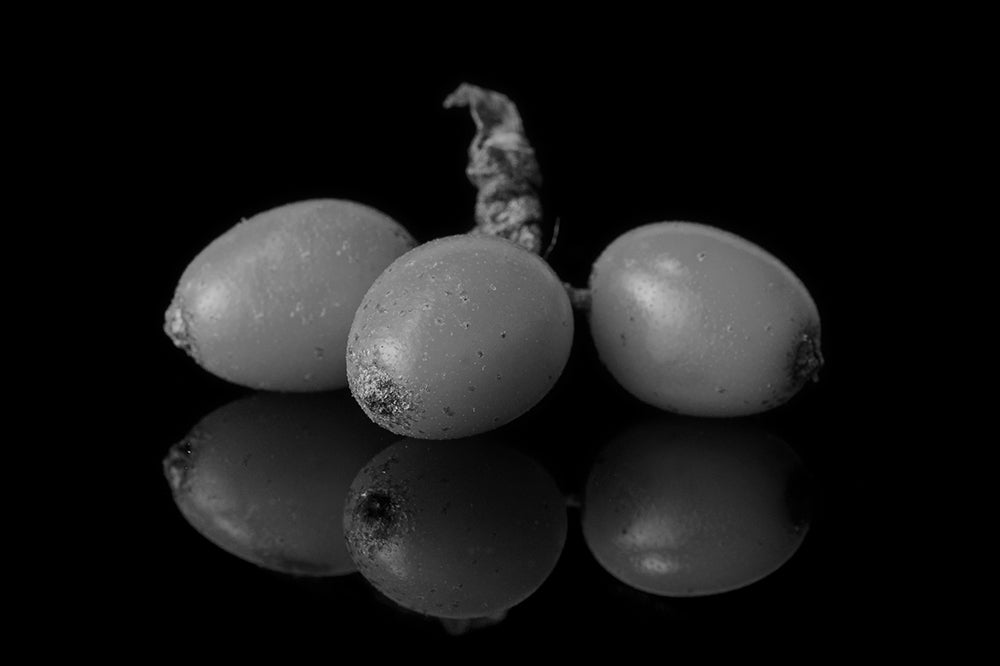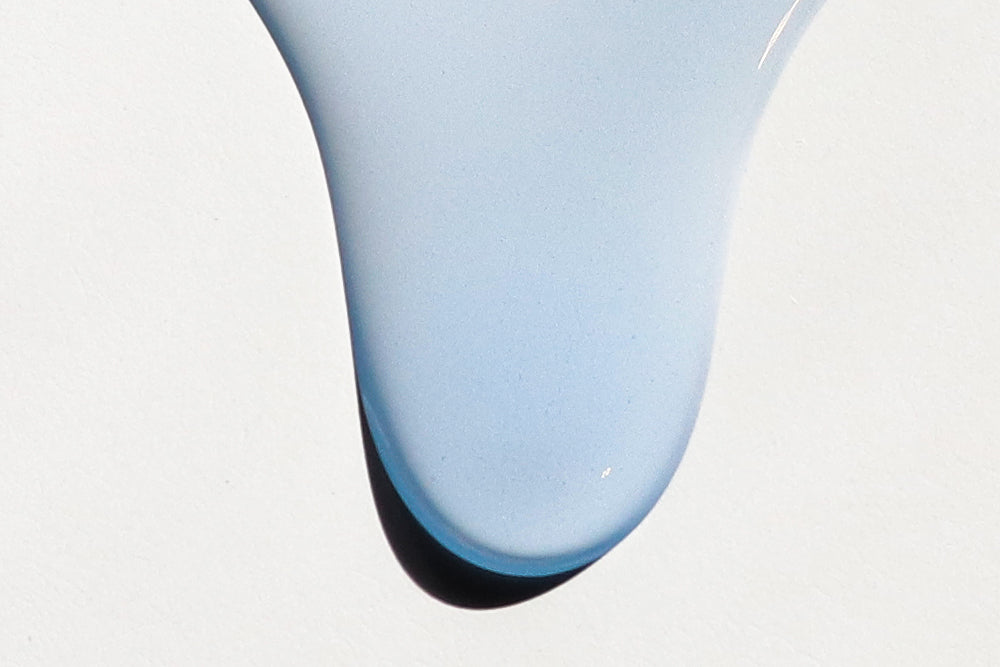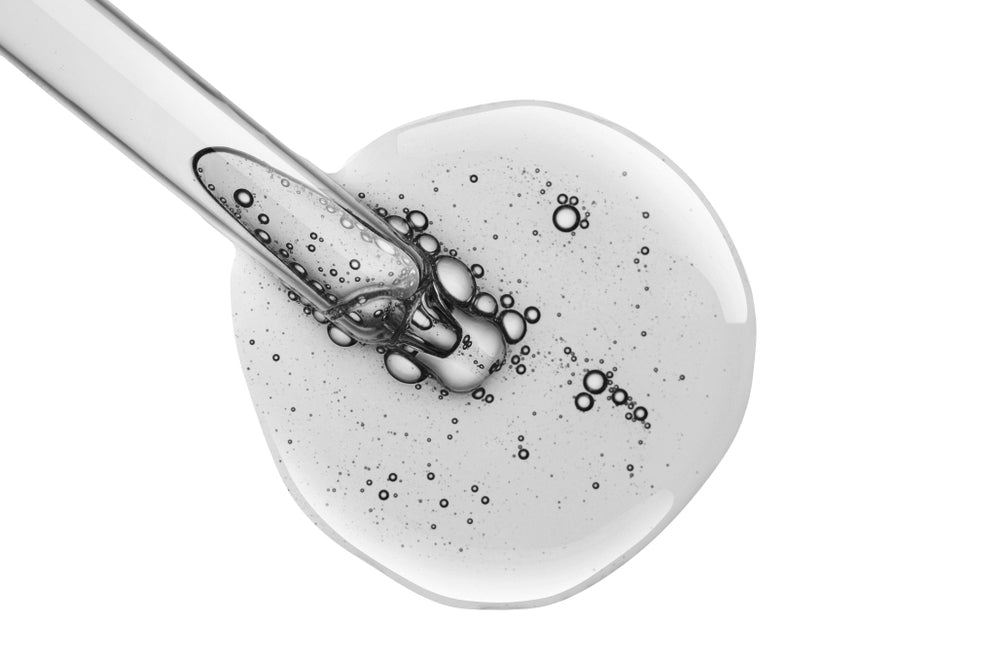
ingredient focus: sea buckthorn seed oil

the bottom line
The first thing that strikes you about sea buckthorn oil is its color, a gorgeous deep orange red. But if the color gets your attention, so should this oil’s benefits. Sea buckthorn contains almost 200 active ingredients, including vitamins, fatty acids, and minerals, that make it tremendously beneficial in skin health for everything from anti-aging to wound healing. To learn more about the remarkable qualities of this unusual fruit, keep reading.
first layer: the history
Also known as Siberian pineapple, sandthorn, sallowthorn, or seaberry, sea buckthorn is a thorny shrub that thrives in the extreme weather and altitude of the Tibetan Himalayas. It’s also found in the mountainous areas of Europe, China, Russia, Mongolia, and Canada, and is able to tolerate both frost and drought. Sea buckthorn berries are yellow or orange and house a smooth stone with an oily seed. Although collection is technically challenging secondary to its spiked branches, the harvest of sea buckthorn berries provides an additional source of income to communities in the Upper Himalayas. While all parts of the shrub have been used, sea buckthorn is most commonly harvested today for the oil derived from its seed and fruit.
second layer: the science
The oil of Hippophae rhamnoides, or sea buckthorn, can be extracted from either the fruit or the seeds. Although both oils are outstanding for use in skincare, they differ in their appearance and properties. Sea buckthorn fruit oil is thicker and dark orange or red secondary to a higher level of carotenoids and resists oxidation, while sea buckthorn seed oil is less viscous and has a less intense orange shade with less oxidative stability than the fruit oil. Both forms of sea buckthorn oil are considered to be carrier oils*.
Among the actives present within sea buckthorn are antioxidants (which fight free radicals and prevent skin damage secondary to environmental injury), vitamins (A, B, C and E), flavonoids (a diverse group of plant chemicals, or phytonutrients, found in almost all fruits and vegetables) and polysaccharides. Sea buckthorn oil also contains complex lipids, including phospholipids and glycolipids, and sterols.*
Sea buckthorn fruit oil is particularly rich in palmitic and palmitoleic (omega-7) fatty acids, while the oil derived from the seed is more notable for the high levels of the essential fatty acids, linoleic (omega-6) and linolenic (omega-3) acids, and oleic acid (omega-9). Sea buckthorn berries are also rich in malic acid and citric acid. While both oils contain very high levels of vitamin E, a potent antioxidant, this is especially notable in oil derived from the berry.
See buckthorn seed oil notably contains omega-3 and omega-6 fatty acids in an almost perfect 1:1 ratio. This balance is critical, as it allows the fatty acids to regulate thousands of metabolic functions through the prostaglandin pathways. Omega-6 fatty acids also improve blood circulation and oxygenation of the skin. These fatty acids are able to penetrate the deeper layers of the skin where they are converted to prostaglandins*, effectively protecting the skin against infections, allergies, inflammation, and aging. Finally, the unsaturated fatty acids, including omega-7 (palmitoleic acid) and omega-6 (gamma linoleic acid) give skin regeneration and skin repair properties.
third layer: the skin
Sea buckthorn oil, from both the seed and fruit, is a valuable ingredient for skincare. Recall that the color of the oil is a clue to its benefits; orange-red ingredients tend to possess regenerative and healing properties, and include both sea buckthorn oil and rosehip oil. The complex lipids found in sea buckthorn oil are able to moisturize and soften the epidermis, improve skin elasticity, reduce inflammation, and accelerate skin regeneration and cell renewal. Sterols strengthen the skin barrier, thereby protecting it from transepidermal water loss. Vitamin A provides skin regeneration and decreases wrinkles formation, vitamin C acts an antioxidant and helps to protect against UVA and UVB radiation while evening skin tone, and vitamin E is a potent antioxidant that protects against free radicals.
Sea buckthorn seed oil has most notably been shown to stimulate wound healing, including the regeneration of the epidermis and collagen synthesis. Sea buckthorn fruit oil also has potential antimicrobial activity secondary to its high content of palmitoleic acid and may inhibit melanin synthesis while increasing skin penetration. Therefore, it’s also indicated for the reduction of acne, inflammation, and allergic reactions. Of note, sea buckthorn oil has very low comedogenicity and does not clog pores.
fourth layer: how we do it
Sea buckthorn is a key ingredient in our bakuchiol & pomegranate facial oil. Created for mature and sensitive skin, our new facial oil features bakuchiol, an alternative to retinol in the treatment of fine lines, pigmentation, and acne. We've layered this beauty onto a base of cucumber, cranberry, pomegranate, and kukui nut oils to gently hydrate and brighten the skin. Sea buckthorn seed and rosehip seed oils help to slow skin maturation while hydrating and healing skin. Bisabolol enhances dermal penetration, while coenzyme Q10 stimulates the production of collagen and elastin.
All this and more at www.anokhaskincare.com .
Add a layer by joining our newsletter: http://bit.ly/anokha_layers
xx
anokha
references:
- Zielinska A, Nowak I. Abundance of active ingredients in sea buckthorn oil. Lipids Health Dis 2017; 16: 95-106.
- Ito H, Asmussen S, Traber DL et al. Healing efficacy of sea buckthorn (Hippophae rhamnoides L.) seed oil in an ovine burn wound model. Burns 2014; 40(3): 511-9. doi: 10.1016/j.burns.2013.08.011. Epub 2013 Sep 3. PMID: 24007892.
- Edraki M, Akbarzadeh A, Hosseinzadeh M et al. Healing effect of sea buckthorn, olive oil, and their mixture on full thickness burn wounds. Adv Skin Wound Care 2014; 27(7): 317-23. doi: 10.1097/01.ASW. 0000451061.85540.f9. PMID: 24932952.
- Cupara SM, Ninkovic MB, Knezevic MG, Vuckovic IM, Jankovic SM. Wound healing potential of liquid crystal structure emulsion with sea buckthorn oil. HealthMED 2011; 5(5): 1218-1223.
- Gupta A, Upadhyay NK, Sawhney RC, Kumar R. A poly-herbal formulation accelerates normal and impaired diabetic wound healing. Wound Repair Regen 2008; 16: 784-790.
- Gupta A, Kumar R, Pal K, et al. Influence of sea buckthorn (Hippophae rhamnoides L.) flavone on dermal wound healing in rats. Mol Cell Biochem 2006; 290: 193-198.
- Bal LM, Meda V, Naik SN, Satya S. Sea buckthorn berries: a potential source of valuable nutrients for nutraceuticals and cosmeceuticals. Food Res Int 44; 1718-1727.
- Yadav A, Stobdan T, Chauhan OP, Dwivedi SK, Chaurasia OP. “Sea Buckthorn: A Multipurpose Medicinal Plant from Upper Himalayas”. In Joshee et al (eds.) Medicinal Plants. Switzerland: Springer Nature. 2019.
*definitions:
carrier oil: a base oil that "carries" essential oils to the skin
flavonoids are part of a diverse group of a diverse group of plant chemicals, or phytonutrients, found in almost all fruits and vegetables. Like carotenoids, they help to give fruits and vegetables their vivid hues. Flavonoids are powerful antioxidants that fight inflammation and help to support the immune system.
phospholipids are are a class of lipids with a hydrophilic (“water-loving”) head and two hydrophobic (“water-hating”) tail. They are major constituents of cell membranes and intracellular organelles and vesicles.
glycolipids are lipids with a carbohydrate attached by a glycosidic bond. They maintain cell membrane stability and facilitate cellular recognition.
sterols are steroid-based alcohols which regulate biological processes and sustain cell membrane structure. They are also known as second messengers, as they pass on messages from outside the cell to facilitate changes within the cell. A famous sterol is cholesterol, which is found only in foods of animal origin.
prostaglandins are a group of lipids made at sites of tissue injury and infection. They play a key role in the inflammatory response by controlling inflammation, blood flow, and blood clot formation.
for more beauty definitions, explore the glossary.
frequently asked questions:
is sea buckthorn oil a carrier oil?
yes, sea buckthorn seed oil and sea buckthorn fruit oil are both considered to be carrier oils. they can be safely used at concentrations up to 100%.
how can I choose the best sea buckthorn oil?
the highest quality sea buckthorn oil should have a bright orange-red color and a sweet scent. the oil derived from the fruit is brighter than that from the seed. if your oil is pale in color or smells rancid, it should be discarded.
what is the sea buckthorn oil comedogenic rating?
sea buckthorn has a very low comedogenic rating of 1 and does not clog pores. it is considered to be non-comedogenic.



leave us a comment
This site is protected by hCaptcha and the hCaptcha Privacy Policy and Terms of Service apply.